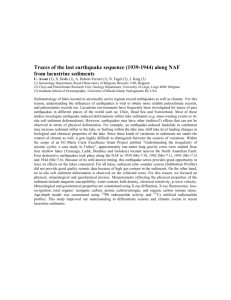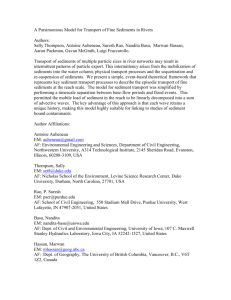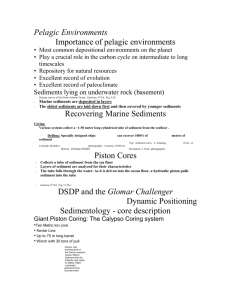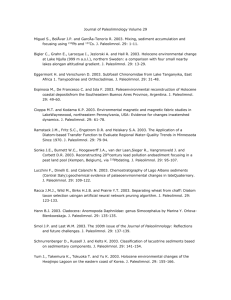Tracking Environmental Change using Lake Sediments
advertisement
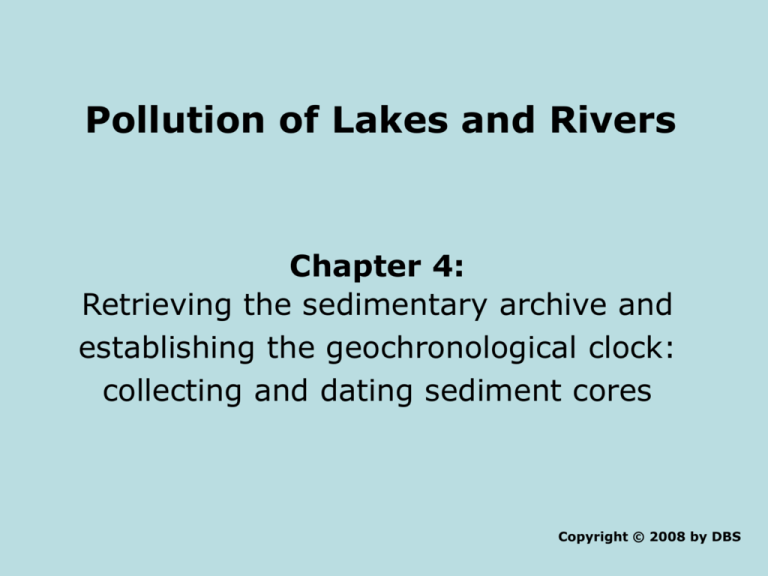
Pollution of Lakes and Rivers Chapter 4: Retrieving the sedimentary archive and establishing the geochronological clock: collecting and dating sediment cores Copyright © 2008 by DBS Contents • • • • • • Collecting and dating sediment cores Retrieving and sampling sediment profiles Setting the time scale: geochronological methods Correlating multiple cores from the same basin The ‘top/bottom approach’: snapshots of environmental change The paleolimnologist’s option of setting the most appropriate scale Retrieving the Sedimentary Archive Collecting and Dating Sediment Cores • What is required? – A sedimentary sequence that is the correct length, resolution and quality – An accurate depth-time profile Retrieving the Sedimentary Archive Retrieving and Sampling Sediment Profiles • Fieldwork – what is it like? • Requires planning • Criteria for good recovery – No disturbance of structure – No change in water content or void ratio – No change in constituent chemistry • Dealing with variable composition – Sites differ markedly in their morphology/climate etc. – Composition may vary within the lake (basin to basin) Retrieving the Sedimentary Archive Retrieving and Sampling Sediment Profiles • Commonly used approaches: Glew, J., Smol, J.P. and Last, W.M. (2001) Sediment core collection and extrusion. In Last, W.M. and Smol, J.P. (eds.), Tracking Environmental Change using Lake Sediments, Volume 1, Basin Analysis, Coring, and Chronological Techniques. Kluwer Academic Publishers, Dordrecht, pp. 73-105. • Long cores: Leroy, S.A.G. and Colman, S.M. (2001) Coring and drilling equipment and procedures for recovery of long lacustrine sediment sequences. In Last, W.M. and Smol, J.P. (eds.), Tracking Environmental Change using Lake Sediments, Volume 1, Basin Analysis, Coring, and Chronological Techniques. Kluwer Academic Publishers, Dordrecht, pp. 107-135. Retrieving the Sedimentary Archive Retrieving and Sampling Sediment Profiles Choosing the coring site • Would like continuous, representative and undisturbed samples • Single cores - take many weeks/months to analyze • Not an issue since replicate cores show very good reproducibility (Charles et al., 1991) • • Ideal: flat, central and deep basin – Bathymetric maps – Technology (depth soundings etc.) Things to avoid – Steep morphometric gradients (slumping) – Shallow areas (prone to mixing) Retrieving the Sedimentary Archive Retrieving and Sampling Sediment Profiles Coring platform • Cores are taken through the water column • From a boat, platform or ice cover • Coring equipment Figure 4.1. Collecting surface lake sediments using a small diameter Glew (1991) gravity corer from the pontoons of a helicopter in Arctic Canada. Retrieving the Sedimentary Archive Retrieving and Sampling Sediment Profiles Coring equipment • Last 100 years contained in 50 cm (N. America) (cf. fast accumulation) • More ancient histories contained in cores 2 m or longer • Recent sediments are ‘unconsolidated’ > 90 % water Short Cores (Surface Sediments) • Open-barrel gravity corers (plastic tubes) – Close-on-contact type (line tension) – Messenger-operated Retrieving the Sedimentary Archive Retrieving and Sampling Sediment Profiles Surface sediments • Freeze-crust samplers (Renberg, 1981, Verchuren, 2000) • Designed to preserve chemistry of the sediment-water interface Figure 4.3. General operation of a freezecrust sampler. Inset: Corer chamber is filled with dry ice and a coolant, such as alcohol. The corer top is secured. A: Corer is lowered through the water column B: Corer is lowered into the sediment, sediment freezes to the corer C: Sediment-encrusted corer brought to the surface. Retrieving the Sedimentary Archive Retrieving and Sampling Sediment Profiles Long Cores • Livingstone corer – Rod driven piston corer Figure 4.4. Simplified diagram showing the basic principles used in piston coring. A) To recover an undisturbed core sample, the corer is positioned at the sediment surface B) The piston held stationary, while the core tube is pushed past it into the sediment using the coring rod. C) The core section is recovered to the surface, with the core tube and piston locked together. The sealing of the piston in the core tube prevents any tendency for the sample to slide out or for the core material to be deformed. Retrieving the Sedimentary Archive Retrieving and Sampling Sediment Profiles • Kullenberg – Cable-operated Livingstone corer – For deep water Figure 4.5. General operation of a Livingstone-type piston corer, showing the lowering (A), sampling (B), and withdrawal (C) of a sediment sequence. The operator uses the drive rods to push the corer into the sediment to the desired depth. A cable, also held by the operator, keeps the piston in place. From Glew et al. (2001); used with permission. Retrieving the Sedimentary Archive Retrieving and Sampling Sediment Profiles Long Cores • Mackereth compressed air piston corer (Mackereth, 1958; 1969) • See Glew et al., 2001 Retrieving the Sedimentary Archive Retrieving and Sampling Sediment Profiles Sediment Sectioning • Photography • Choice of division may be based on visible mixing • Should be sectioned lake-side / ASAP Retrieving the Sedimentary Archive Setting the Time Scale: Geochronological methods • Radioisotopic techniques – Measure decay of naturally occurring radioisotopes – 210Pb (t1/2 = 22.3 yrs) most commonly used (for recent sediments ~150 yrs) • 210Pb – – Dating Supported 210Pb (in-situ decay of 238U) Unsupported 210Pb (from atmosphere) (= total 210Pb – Supported 210Pb) Assumptions: Rate of deposition of unsupported 210Pb is constant Transfer of 210Pb from the water column to sediments No disturbances: mixing/additions from catchment inflows Retrieving the Sedimentary Archive Setting the Time Scale: Geochronological methods Retrieving the Sedimentary Archive Setting the Time Scale: Geochronological methods • 210Pb dating example ln (unsupported 210Pb activity) Pbx Pb0 0 x Depth (cm) t = 1 ln(210Pb0 / 210Pbx) λ Slope; m = - λ / a Where a = sedimentation rate Retrieving the Sedimentary Archive Setting the Time Scale: Geochronological methods • Other radioisotopic indicators – 137Cs from bomb tests and Chernobyl (also 241Am) – Peaks in 1954, 1958, 1962 (Test ban treaty, 1986) Appleby, 2001 Retrieving the Sedimentary Archive Setting the Time Scale: Geochronological methods • 14C used for longer sequences production via cosmic rays 1 n 0 + 147N → 146C + 11H • Atmospheric 14C is found in 14CO2 • Incorporated into plants where it decays – Whilst alive 14C/12C ratio is constant – After death 14C no longer replaced from environment – Useful for about 7 half-lives t1/2 = 5,730 yr Retrieving the Sedimentary Archive Setting the Time Scale: Geochronological methods • • • Pollen chronologies – Introduction, proliferation and demise of plant species – e.g. Ambrosia (ragweed) ~ European settlement Episodic events – e.g. volcanic ash from known eruptions (Tephrachronology) – e.g. Charcoal from forest fires Other anthropogenic time markers – Chemicals from anthropogenic activity Retrieving the Sedimentary Archive Setting the Time Scale: Geochronological methods • Annually laminated sediments (varves) – Similar to tree rings – Very few varve forming lakes Figure 4.9. Annual couplets (varves) of sediment from Nicolay Lake, Nunavut, Arctic Canada. Photograph taken by S. Lamoureux. Retrieving the Sedimentary Archive The ‘Top/Bottom Approach’: Snapshots of Environmental Change • • • Time consuming to analyze every layer With multiple lakes + cores the no. of samples increases “before and after” type questions do not require entire core e.g. are lakes currently more acidic than 1850’s? Cumming et al., 1992 Retrieving the Sedimentary Archive The Paleolimnologist’s Option of Setting the Most Appropriate Time Scale • • Ecosystems change and respond to stress over varying time-scales Paleolimnology allows the scientists to set their own time-scale Retrieving the Sedimentary Archive Summary • • • Collection and dating is a crucial first part of any study 210Pb most common dating technique for recent sediments Top/bottom approach may be used if detailed analysis not required References • • • • • • • Anderson, T.W. (1974) The chestnut pollen decline as a time horizon in lake sediments in eastern North America. Canadian Journal of Earth Sciences, Vol. 11, pp. 678-685. Appleby, P.G. (1993) Foreward to the lead-210 dating anniversary series. Journal of Paleolimnology, Vol. 9, pp. 155-160. Appleby, P.G. (2001) Chronostratigraphic techniques in recent sediments. In Last, W.M. and Smol, J.P. (eds.), Tracking Environmental Change using Lake Sediments, Volume 1, Basin Analysis, Coring, and Chronological Techniques. Kluwer Academic Publishers, Dordrecht, pp. 171-203. Appleby, P.G. and Oldfield, F. (1978) The calculation of 210Pb dates assuming a constant rate of supply of unsupported 210Pb to the sediment. Catena, Vol. 5, pp. 1-8. Appleby, P.G., Richardson, N. and Nolan, P.J. (1991) 241Am dating of lake sediments. Hydrobiolgia, Vol. 214, pp. 35-42. Bennett, K.D. and Willis, K.J. (2001) Pollen. In Smol, J.P., Birks, H.J.B. and Last, W.M. (eds.) Tracking Environmental Change using Lake Sediments, Volume 3, Terrestrial, Algal, and Silaceous Indicators. Kluwer Academic Publishers, Dordrecht, pp. 5-32. Birks, H.H. (2001) Plant macrofossils. In Smol, J.P., Birks, H.J.B. and Last, W.M. (eds.) Tracking Environmental Change using Lake Sediments, Volume 3, Terrestrial, Algal, and Silaceous Indicators. Kluwer Academic Publishers, Dordrecht, pp. 49-74. References • • • • • • • Björck, S. and Wohlfarth, B. (2001) 14C chronostratigraphic techniques in paleolimnology. In Last, W.M. and Smol, J.P. (eds.), Tracking Environmental Change using Lake Sediments, Volume 1, Basin Analysis, Coring, and Chronological Techniques. Kluwer Academic Publishers, Dordrecht, pp. 205-245. Blais, J.M., Kalff, J., Cornett, R.J. and Evans R.D. (1995) Evaluation of 210Pb dating in lake sediments using stable Pb, Ambrosia pollen, and 137Cs. Journal of Paleolimnology, Vol. 13, pp. 169-178. Boyle, J.F. (1995) A simple closure mechanism for a compact, large-diameter gravity corer. Journal of Paleolimnology, Vol. 13, pp. 85-87. Brinkhurst, R.O., Chua, K.E. and Batoosingh, E. (1969) Modifications in sampling procedures applied to studies on the bacteria and tubified oligochaetes inhabiting aquatic sediments. Journal of the Fisheries Research Board of Canada, Vol. 26, pp. 2581-2593. Charles, D.F., Dixit, S.S., Cumming, B.F. and Smol, J.P. (1991) Variability in diatom and chrysophyte assemblages and inferred pH: paleolimnological studies of Big Moose L., N.Y. Journal of Paleolimnology, Vol. 5, pp. 267-284. Cumming, B.F., Smol, J.P., kingston, J.C., Charles, D.F., Birks, H.J.B., Camburn, K.E., Dixit, S.S., Uutala, A.J. and Selle, A.R. (1992) How much acidification has occurred in Adriondack region (New York, USA) lakes since preindustrial times? Canadian Journal of Fisheries and Aquatic Sciences, Vol. 49, pp. 128-141. Cumming, B.F., Glew, J.R., Smol, J.P. and Norton, S.A. (1993) Comment on ‘Core compression and surficial sediment loss of lake sediments of high porosity caused by gravity coring’ (Crusius and Anderson). Limnology and Oceanography, Vol. 38, pp. 695699. References • • • • • • • • Damon, E., Donahue, D.J., Gore, B.H., Hatheway, A.L., Jull, A.J.T., Linick, W., Sercel, P.J., Toolin, A.J., Bronk, C.R., Hall, E.T., Hedges, E.M., Housley, R., Law, I.A., perry, C., Bonani, G., Trumbore, S., Woelfli, W., Ambers, J.C., Bowman, G.E., Leese, M.N. and Tite, M.S. (1989) Radiocarbon dating of the Shroud of Turin. Nature, Vol. 337, pp. 611-614. Davidson, G.A. (1988) A modified tape-peel technique for preparing permanent qualitative microfossil slides. Journal of Paleolimnology, Vol. 1, pp. 229-234. Davis, R.B., Hess, C.T., Norton, S.A., hanson, D.W., Hoagland, K.D. and Andreson, D.S. (1984) 137Cs and 210Pb dating of sediments from soft-water lakes in New England (U.S.A.) and Scandinavia, a failure of 137Cs dating. Chemical Geology, Vol. 44, pp. 151-155. Dixit, S.S., Dixit, A.S. and Smol, J.P. (1992) Assessment of changes in lake water chemistry in Sudbury area lakes since preindustrial times. Canadian Journal of Fisheries and Aquatic Sciences, Vol. 49, pp. 8-16. Foster, D.L., Mighall, T.M., Proffitt, H., Walling, D.W. and Owens, P.N. (2006) Postdepositional 137Cs mobility in the sediments of three shallow coastal lagoons, SW England. Journal of Paleolimnology, Vol. 35, pp. 881-995. Glew, J. (1988) A portable extruding device for close interval sectioning of unconsolidated core samples. Journal of Paleolimnology, Vol. 1, pp. 235-239. Glew, J. (1989) A new trigger mechanism for sediment samplers. Journal of Paleolimnology, Vol. 2, pp. 241-243. Glew, J. (1991) Miniature gravity corer for recovering short sediment cores. Journal of Paleolimnology, Vol. 5, pp. 285-287. References • • • • • • • Glew, J. (1995) Conversion of shallow water gravity coring equipment for deep water operation. Journal of Paleolimnology, Vol. 14, pp. 83-88. Glew, J., Smol, J.P. and Last, W.M. (2001) Sediment core collection and extrusion. In Last, W.M. and Smol, J.P. (eds.), Tracking Environmental Change using Lake Sediments, Volume 1, Basin Analysis, Coring, and Chronological Techniques. Kluwer Academic Publishers, Dordrecht, pp. 73-105. Hvorslev (1949) Subsurface Exploration and Sampling Soils for Civil Engineering Purposes. Vicksburg, MI: American Society of Civil Engineers. Waterways Experiment Station, Corps of Engineering Purposes, U.S. Army. Kajak, Z., Kacprzak, K. and Polowski, R. (1965) Chwytacz rurowy do pobierania préb dna. Ekologia Polska Seria B, Vol. 11, pp. 159-165. Kansanen, P.H., Jaakkola, T., Kulmala, S. and Suutarinen, R. (1991) Sedimentation and distribution of gamma-emitting radionuclides in bottom sediments of southern lake Päijänne, Finalnd after the Chernobyl accident. Hydrobiologia, Vol. 222, pp. 121-140. Kemp, A.E.S., Dean, J., Pearce, R.B. and Pike, J. (2001) Recognition and analysis of bedding and sediment fabric features. In Last, W.M. and Smol, J.P. (eds.), Tracking Environmental Change using Lake Sediments, Volume 2, Physical and Geochemical Methods. Kluwer Academic Publishers, Dordrecht, pp. 7-22. Kilby, G.W. and Batley, G.E. (1993) Chemical indicators of sediment chronology. Australian Journal of marine and Freshwater Research, Vol. 44, pp. 635-647. References • • • • • • • Krisnaswami, S., Lal, D., Martin, J.M. and Meybeck, M. (1971) Geochronology of lake sediments. Earth and Planetary Science Letters, Vol. 11, pp. 407-414. Kullenberg , B. (1947) The piston core sampler. Svenska Hydrografisk-Biologiska Kommissionens, Skrifter III, Hydrograpfi, Vol. 1, pp. 1-14. Lamoureux, S. (2001) Varve chronology techniques. In Last, W.M. and Smol, J.P. (eds.), Tracking Environmental Change using Lake Sediments, Volume 1, Basin Analysis, Coring, and Chronological Techniques. Kluwer Academic Publishers, Dordrecht, pp. 247260. Last, W.M. and Smol, J.P. (eds.) (2001) Tracking Environmental Change using Lake Sediments, Volume 2, Physical and Geochemical Methods. Kluwer Academic Publishers, Dordrecht. Leroy, S.A.G. and Colman, S.M. (2001) Coring and drilling equipment and procedures for recovery of long lacustrine sediment sequences. In Last, W.M. and Smol, J.P. (eds.), Tracking Environmental Change using Lake Sediments, Volume 1, Basin Analysis, Coring, and Chronological Techniques. Kluwer Academic Publishers, Dordrecht, pp. 107135. Livingstone, D.A. (1955) A lightweight piston sampler for lake deposits. Ecology, Vol. 36, pp. 137-139. MacDonald, G.M., Beukens, R.P., Kieser, W.E. and Vitt, D.H. (1991) Comparative radiocarbon dating of terrestrial plant macrofossils and aquatic moss from the ‘ice-free corridor’ of western Canada. Geology, Vol. 15, pp. 837-840. References • • • • • • • Mackereth, F.J.H. (1958) A portable core sampler for lake deposits. Limnology and Oceanography, Vol. 3, pp. 181-213. Mackereth, F.J.H. (1969) A short core sampler for subaqueous deposits. Limnology and Oceanography, Vol. 14, pp. 145-151. Oldfield. F. and Appleby, P.G. (1984) Empirical testing of 210Pb-dating models for lake sediments. In Haworth, E.Y. and Lund, J.W.G. (eds.), Lake Sediments and Environmental History. University of Minnesota Press, Minneapolis, pp. 93-124. Pennington, W., Cambray, R.S. and Fisher, E.M. (1973) Observations on lake sediments using fallout 137Cs as a tracer. Nature, Vol. 242, pp. 324-326. Renberg, I. (1981) Improved methods for sampling, photographing and varve-counting of varved lake sediments. Boreas, Vol. 10, pp. 255-258. Renberg, I. and Wik, M. (1984) Dating of recent lake sediments by soot article counting. Verhandlungen der Internationalen Vereinigung von Limnologen, Vol. 22, pp. 712-718. Renberg, I. (1991) The HON-Kajak sediment corer. Journal of Paleolimnology, Vol. 6, pp. 167-170. References • • • • • • • Robins, J.A. (1978) Geochemical and geophysical applications of radioactive lead. In Nriagu, J.O. (ed.), Biogeochemistry of Lead in the Environment. Elsevier Scientific, Amsterdam, pp. 285-393. Rose. N. (2001) Fly-ash particles. In Last, W.M. and Smol, J.P. (eds.), Tracking Environmental Change using Lake Sediments, Volume 2, Physical and Geochemical Methods. Kluwer Academic Publishers, Dordrecht, pp. 319-349. Saarinen, T. and Petterson, G. (2001) Image analysis techniques. In Last, W.M. and Smol, J.P. (eds.), Tracking Environmental Change using Lake Sediments, Volume 2, Physical and Geochemical Methods. Kluwer Academic Publishers, Dordrecht, pp. 23-39. Scholz , C.A. (2001) Applications of seismic sequence stratigraphy in lacustrine basins. In Last, W.M. and Smol, J.P. (eds.), Tracking Environmental Change using Lake Sediments, Volume 1, Basin Analysis, Coring, and Chronological Techniques. Kluwer Academic Publishers, Dordrecht, pp. 7-22 Simola, H. (1977) Diatom succession in the formation of annually laminated sediment in Lovojärvi, a small eutrophicated lake. Annals Botanica Fennici, Vol. 18, pp. 160-168. Simola, H., Hanski, I. and Liukkonen, M. (1990) Stratigraphy, species richness and seasonal dynamics of planktonic diatoms during 418 years in Lake Lovojärvi,, South Finalnd. Annals Botanica Fennici, Vol. 27, pp. 241-259. Smol, J.P. and Dickman, M.D. (1981) The recent histories of three Canadian Shield lakes: a paleolimnological experiment. Archiv für Hydrobiologie, Vol. 93, pp. 83-108. References • • • • • • • • Stephenson, M., Klaverkamp, J., Motycka, M., baron, C. and Schwartz, W. (1996) Coring artifacts and contaminant inventories in lake sediment. Journal of Paleolimnology, Vol. 15, pp. 99-106. Stuiver, M., Reimer, P.J., Bard, E. et al. (1998) INTCAL98 radiocarbon age calibration, 24,000-0 cal BP. Radiocarbon, Vol. 40, pp. 1041-1083. Turney, C.S.M. and Lowe, J.J. (2001) Teprochronology. In Last, W.M. and Smol, J.P. (eds.), Tracking Environmental Change using Lake Sediments, Volume 1, Basin Analysis, Coring, and Chronological Techniques. Kluwer Academic Publishers, Dordrecht, pp. 451471. Verschuren, D. (2000) Freeze coring soft sediments in tropical lakes. Journal of Paleolimnology, Vol. 24, pp. 361-365. Whitlock, C. and Larsen, C.P.S. (2001) Charcoal as a fire proxy. In Smol, J.P., Birks, H.J.B. and Last, W.M. (eds.) Tracking Environmental Change using Lake Sediments, Volume 3, Terrestrial, Algal, and Silaceous Indicators. Kluwer Academic Publishers, Dordrecht, pp. 75-97. Wright, H.E. Jr. (1990) An improved Hongve sampler for surface sediments. Journal of Paleolimnology, Vol. 4, pp. 91-92. Wright, H.E. Jr. (1991) Coring tips. Journal of Paleolimnology, Vol. 6, pp. 37-49. Zolitschka, B., Mingram, J., van der Gaast, S., Jansen, J.H.F. and Naumann, R. (2001) Sediment logging techniques. In Last, W.M. and Smol, J.P. (eds.), Tracking Environmental Change using Lake Sediments, Volume 1, Basin Analysis, Coring, and Chronological Techniques. Kluwer Academic Publishers, Dordrecht, pp. 137-153.

